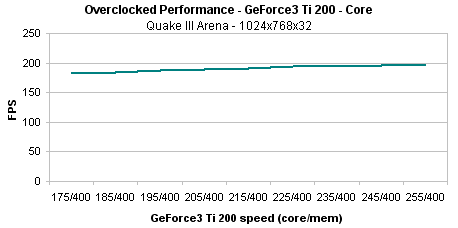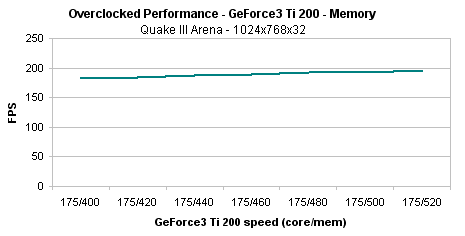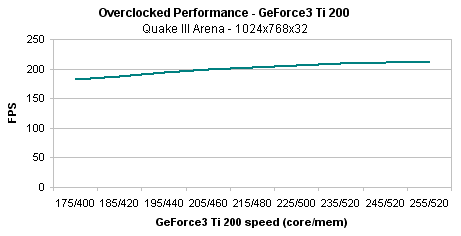NVIDIA GeForce2/3 Titanium Roundup - January 2002
by Matthew Witheiler on January 30, 2002 9:33 PM EST- Posted in
- GPUs
Overclocking the GeForce3 Ti 200
Like the GeForce3 Ti 500, the GeForce3 Ti 200 received some modifications in order to gain the Titanium badge. This time, to distinguish itself from it's older brother, the GeForce3 Ti 200 actually took a performance hit. Losing 25MHz from the core clock and 30MHz (60MHz DDR) from the memory clock, the GeForce3 Ti 200 hit shelves at 175MHz/400MHz DDR. Clearly, altering the clock speed for the GeForce3 Ti 200 changed how the card responds to overclocking. Let's see how.
For testing we used the GeForce3 Ti 200 card that we were able to overclock the highest: the Gainward GeForce3 Ti/450. In our testing we were able to push the card to a 255MHz core speed and a 520MHz memory speed, resulting in a 80MHz core speed boost and a 120MHz DDR memory speed boost. What happened when we pushed the core up to the 255MHz level?

Overclocking only the GeForce3 Ti 200 core provided a noticeable speed increase. Increasing the core speed from the stock speed to the maximum core speed possible resulted in a 15.6 FPS gain; a performance increase which equates to a 8.6% speed increase. There was no sign of slowdown when it came to the higher core speeds: card performance kept increasing until the core clock speed got so high that it refused to run.
As you can tell by the graph, increasing the core clock speed seemed to increase the speed of the card in a fairly linear fashion. As a result of this trait, we are able to fit a linear regression line to the data. The best fit line in this case has the following equation: f(x)=0.191x+183.322 where x is the measure of MHz over the stock clock speed. Using this line we can see that each 1 MHz that the core clock is pushed, our game performance increased .191 FPS or approximately a .1% gain. Using this information we can infer that it would take a core overclock of about 5MHz to increase Quake III Arena performance by 1 FPS at 1024x768x32.
Below is what happened when we left the core clock speed the same but increased the memory clock at a constant rate of 20MHz per interval.

Pushing the memory speed of our GeForce3 Ti 200 card up to 520MHz DDR (260 MHz SDR) resulted in a nice speed boost. We were able to increase our Quake III Arena scores by 13 FPS, resulting in a 7.1% speed boost. Much like we saw with the core overclock, performance did not level off as the memory clock speed got higher, suggesting that the memory bus does act as a bottleneck of some sort.
Once again, the data gathered when overclocking the memory clock seemed to fall in a rather linear fashion. As a result of this we were able to find a fairly accurate regression line to the data. The equation best fitting the points is f(x)=.109x+182.704. Comparing this to the regression line calculated with the core overclocked data, we see that each MHz of increased memory speed provides about half the performance gain obtained by each core speed MHz increase. At this slope, it would take about a 10MHz DDR (5MHz SDR) overclock in the memory bus to increase Quake III Arena performance at 1024x768x32 by 1 FPS. Using this information it seems that overclocking the core clock of the GeForce3 Ti 200 provides more bang for the buck than overclocking the memory bus does. Does this mean that you should only worry about overclocking your card's core? Let's take a look at what happened when we overclocked both the memory and the core of the GeForce2 Ti 200.

As it turns out, it seems that the GeForce3 Ti 200 reacts best when both the core and the memory clocks are increased. Bringing the clock speed up to 255MHz/520MHz from the stock speed of 175MHz/400MHz resulted in a 15.8% speed increase, or a 28.8 FPS increase. By far this is a much larger speed increase than we saw when we overclocked just the core or just the memory alone. It also brought the clock speed to a higher level than the stock GeForce3 Ti 500 speed; the 255MHz/520MHz speed that we were able to get the GeForce3 Ti 200 to was 15MHz over the GeForce3 Ti 500 stock core speed and 20MHz over the GeForce3 Ti 500 stock memory speed.
The trend in the data obtained when overclocking the core and the memory of the GeForce3 Ti 200 seemed to decrease gradually as clock speed increased. This could be due to the fact that we were forced to stop overclocking the memory bus of the card at 520MHz so we therefore used this memory speed at the core speeds of 235MHz and above. Fitting a linear regression line to the data we find that it is best approximated by f(x)=0.365x+185.769. Clearly, just by examining the slope of the regression line, we can see that increasing both the core and the memory clock provides a larger performance boost than just increasing the core or the memory clock speed alone. The slope of 0.365 shows that for every 1MHz that the core clock is increased and 2MHz that the memory clock is increased, game performance in Quake III Arena at 1024x768x32 increased by 0.365 FPS. At this slope, it would take a 3MHz core clock increase and a 6MHz memory clock speed increase to gain an extra 1 FPS in our test.
For those of you with a bit more math knowledge, you may notice that the data above fits a logistic regression line better than a linear regression line. If you are curious, the logistic equation is: f(x)=217.303/(1+.0195e^(0.025x)).










0 Comments
View All Comments